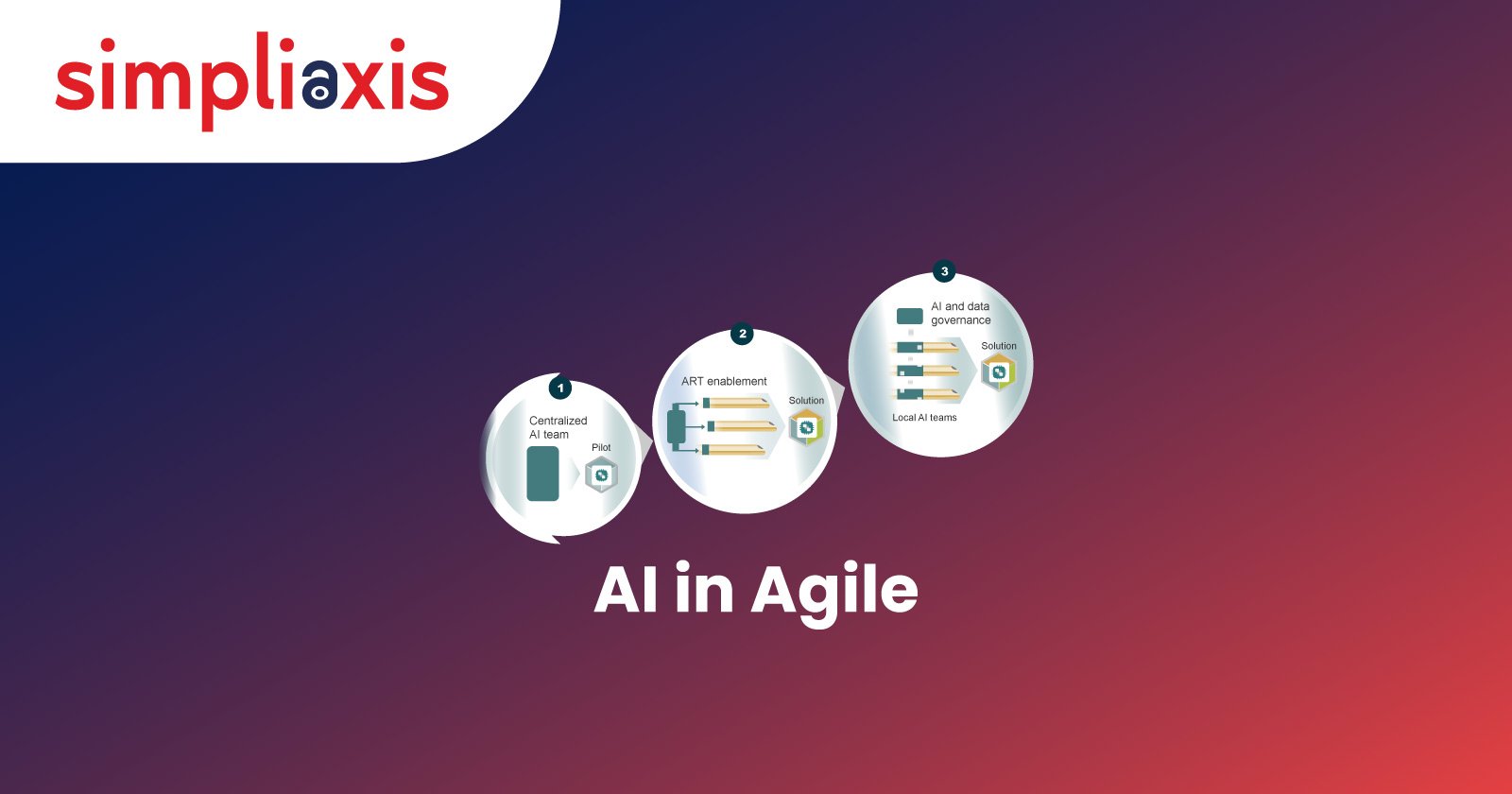Implementing AI in Agile methodology is the ultimate transformative journey for your career changing path. In this trending market era, businesses constantly seek ways to smooth their processes, boost productivity, and enhance overall efficiency. Two prominent methodologies at the forefront of this transformation are Agile and Artificial Intelligence (AI). While Agile revolutionizes project management with its iterative, collaborative approach, AI offers extraordinary capabilities in automation, prediction, and decision-making. Combined, they form a powerful synergy that propels organizations toward greater success. In this blog will discuss how AI is continuously helping in the Agile Methodology.
Know: Agile Transformation
Definition of Agile:
Agile methodology is an important approach to project management that divides a project into manageable phases, emphasizing ongoing collaboration, flexibility, and improvement. Except for the traditional "waterfall" method, which maintains a linear progression where one team completes its part before passing it to the next, Agile promotes the formation of cross-functional teams that work together throughout the project. This method involves a repetitive cycle of planning, executing, and evaluating tasks.
Central to Agile are open communication, teamwork, adaptability, and mutual trust. While the project lead or product owner sets the preferences for what needs to be accomplished, the team collectively decides on the execution strategies, self-organizing around specific tasks. Agile is characterized by its focus on short feedback loops and continuous enhancement rather than a strict set of practices or techniques. This path allows teams to respond quickly to changes and consistently improve the product and the process.
Also, read: What is Agile Framework
Definition of Artificial Intelligence (AI)
Artificial Intelligence, refers to the simulation of human intelligence processes by machines, typically computer systems. AI surrounds a broad range of technologies, including natural language processing, machine learning, computer vision, and robotics. Its capabilities extend from automating repetitive tasks to making complex predictions and decisions based on data analysis.
Benefits of AI in Agile
- Enhanced Productivity:
AI tools can automate constant and time-consuming tasks, allowing Agile teams to focus on more complex and creative aspects of their projects. For example, AI can handle tasks like code reviews, bug tracking, and generating reports, thus speeding up the development process and reducing manual workload.
- Enhanced Decision-Making:
AI systems can determine large volumes of data quickly and accurately, providing insights that help Agile teams make informed decisions. By leveraging AI's data analysis capabilities, teams can better understand project performance, identify risks, and optimize resource allocation, leading to more effective and timely decision-making.
- Predictive Analytics:
AI's predictive analytics capabilities allow Agile teams to anticipate potential issues and hold-up before they arise. By analyzing past project data and current trends, AI can forecast future challenges and suggest proactive measures to mitigate risks, ensuring smoother project execution and timely delivery.
- Optimized Resource Allocation:
AI recommends optimal task allocation based on team members' strengths and availability, leading to better resource utilization and balanced workloads.
- Enhanced Quality Assurance:
Continuous testing and monitoring by AI tools identify bugs and performance issues in real time, ensuring higher quality outputs and faster defect resolution.
Implementing AI in Agile
Implementing AI in an Agile environment requires careful integration of AI development processes with Agile methodologies. Here's a comprehensive guide to achieving this integration effectively:
Understanding AI and Agile:
AI Development involves creating algorithms and models that can learn from data to perform tasks that typically require human Intelligence. This process includes data collection, preprocessing, model training, evaluation, and deployment.
Agile Methodology is an iterative approach to project management and software development that promotes continuous delivery, collaboration, and flexibility. Key frameworks include Scrum, Kanban, and Lean.
Aligning AI Development with Agile Principles:
- Iterative Development: Break down AI projects into smaller, manageable increments. Instead of aiming for a fully functional AI solution in one go, focus on delivering a minimum viable product (MVP) that can be iteratively improved.
- Collaboration: Help to close collaboration among cross-functional teams, including data scientists, machine learning engineers, domain experts, and product owners. Regular communication ensures that the AI model aligns with business needs.
- Customer Feedback: Incorporate feedback loops from stakeholders and end-users to refine AI models. This helps in validating the AI outputs against real-world requirements and improving model accuracy and relevance.
- Flexibility: Be prepared to pivot based on findings from data exploration and model evaluation. Agile's flexible nature allows teams to adapt to new insights and changing requirements.
Agile Frameworks for AI Projects Scrum:
- Sprints: Implement AI tasks in short, time-boxed sprints, typically 2-4 weeks long. Each sprint should aim to deliver a usable increment of the AI system.
- Roles: Define roles such as Scrum Master, Product Owner, and Development Team. For AI projects, include roles like Data Scientist and AI Engineer within the development team.
- Meetings: Conduct regular Scrum ceremonies, including Daily Standups, Sprint Planning, Sprint Reviews, and Retrospectives to ensure continuous progress and improvement.
Kanban:
- Visualize Workflow: Use Kanban boards to visualize the AI development process, highlighting tasks like data preprocessing, model training, and validation.
- Limit Work in Progress (WIP): Control the number of tasks in progress to avoid overloading the team and ensure focus on current tasks.
- Continuous Delivery: Emphasize continuous integration and deployment of AI models, ensuring frequent releases and updates.
Tools and Technologies
- Version Control Systems: Use Git or other version control systems to manage changes in code and data.
- Continuous Integration/Continuous Deployment (CI/CD): Implement CI/CD pipelines to automate the testing and deployment of AI models, ensuring that new changes are continuously integrated and deployed.
- Project Management Tools: Utilize tools like Jira, Trello, or Asana to manage Agile workflows, track progress, and facilitate team collaboration.
Check out: Best Project Management Tools
Addressing AI-Specific Challenges in Agile
- Data Management: Ensure proper data governance, including data collection, storage, and preprocessing. Agile sprints can include tasks specifically focused on data handling.
- Model Validation: Implement robust validation techniques to evaluate model performance. This includes splitting data into training and test sets, cross-validation, and using appropriate metrics.
- Experimentation: Understand the experimental nature of AI by allowing for exploration within sprints. Allocate time for research and experimentation to test different algorithms and approaches.
- Ethics and Bias: Continuously monitor and reduce ethical concerns and biases in AI models. Agile retrospectives can be used to reflect on these aspects and make necessary adjustments.
Continuous Learning and Improvement
- Retrospectives: Regularly conduct retrospectives to reflect on what went well and what could be improved. Use these insights to refine processes and practices for future sprints.
- Training and Development: Invest in ongoing training to keep team members updated on the latest AI and Agile methodologies.
Market Trends of AI in Agile Project Management
AI into Agile project management was gaining momentum, with several notable market trends:
- AI-powered Agile Tools: There was a rise in the development and adoption of AI-enhanced Agile project management tools. These tools leverage AI algorithms for various purposes, such as predictive analytics for better sprint planning, natural language processing for automated documentation, and sentiment analysis for team collaboration insights.
- Predictive Analytics for Sprint Planning: AI-driven predictive analytics tools were becoming increasingly popular for Agile teams. These tools analyze historical data from past sprints to forecast potential bottlenecks, estimate task completion times, and optimize resource allocation for future sprints.
- Automated Task Assignment and Prioritization: AI algorithms were being used to automate task assignment and prioritization in Agile projects. By analyzing factors such as team member skills, task dependencies, and project deadlines, AI systems can intelligently assign tasks to the most suitable team members and prioritize them based on project goals.
Also, know: Agile Prioritization Techniques
- Enhanced Decision Support: AI was providing Agile teams with enhanced decision support capabilities. Machine learning algorithms were being utilized to analyze project data, identify patterns, and provide actionable insights to project managers and team members, empowering them to make informed decisions and course corrections in real-time.
- Natural Language Processing (NLP) for Automated Documentation: NLP-powered tools were emerging to automate documentation tasks in Agile projects. These tools can extract relevant information from team communications, such as meeting transcripts and chat logs, and automatically generate project documentation, user stories, and sprint reports, thereby reducing administrative overhead and improving documentation quality.
- AI-driven Quality Assurance (QA): AI technologies like machine learning and computer vision were being integrated into Agile QA processes. AI-driven testing tools can impulsively generate test cases, identify potential bugs, and even perform automated testing of user interfaces, leading to faster and more reliable software releases.
- Ethical AI Considerations: With the increasing use of AI in Agile project management, there was a growing emphasis on ethical AI considerations. Organizations were paying more attention to issues such as data privacy, algorithmic bias, and transparency in AI decision-making and incorporating ethical guidelines into their Agile development processes.
Check:Why use Agile Project Management?
Conclusion
Implementing AI in Agile requires a balanced approach that leverages the strengths of both domains. By iterating on AI models, fostering collaboration, and remaining flexible, teams can effectively integrate AI development into Agile frameworks, leading to continuous delivery of valuable AI solutions. Integrating AI into Agile methodologies offers numerous benefits, from increased productivity to improved decision-making and predictive analytics. By starting small, ensuring team collaboration, and continuously monitoring performance, Agile teams can effectively leverage AI to enhance their workflows and achieve better outcomes.













 +1-361-998-9988
+1-361-998-9988


